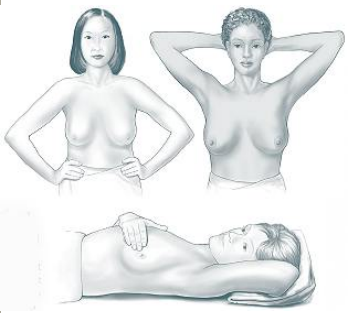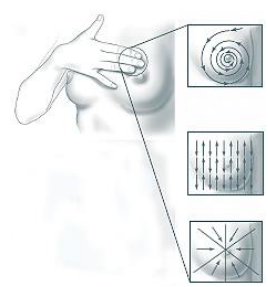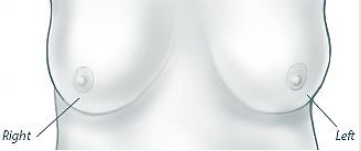A breast self-exam is done to detect changes that could lead to breast cancer. To learn what is normal for your breasts and to find any problems, you should do a breast self-exam once a month. It is one of the best things you can do for your health. Finding and treating breast cancer early can save your life.
By doing routine breast self-exams and having routine mammograms and checkups, you can help detect breast problems early.
This page will explain:
- how to do a breast self-exam
- why it is key to your health
- signs of a problem
Why Do Breast Self-Exams?
If breast cancer is found early, most women can be treated with success. That is why routine breast self-exams, mammography, and checkups by your doctor are vital (see below).
By doing a monthly breast self-exam, you learn how your breasts feel. This helps you detect any changes or signs of a problem.
All women should do the exam once a month. This includes women who
- have gone through menopause
- are pregnant
- are breast-feeding
- have breast implants
Any changes or lumps should be discussed with your doctor right away.
When Should I Have Screening Tests?
| Test | How Often |
| Mammography | Every 1-2 years for women aged 40-50 years. Once a year for women 50 years and older. Once a year for a woman who has a first-degree relative (mother, sister, or daughter) or more than one other relative with breast cancer or ovarian cancer that occurred before menopause. |
| Doctor’s exam of breasts | Once a year. |
| Breast self-exam | Once a month. |
How to Do a Breast Self-Exam
The best time to do the breast self-exam is a few days after your period ends each month. Your breasts are less tender or swollen at this time. If you are not having periods, try to do the exam on the same day each month. Some women choose the first day of each month to help them remember. There are two parts to a breast self-exam—looking and feeling.
Looking
The self-exam should always be done in good light. Stand or sit in front of a mirror. Place arms at your sides. Look for dimpling, puckering, or redness of the breast skin, discharge from the nipples, or changes in breast size or shape. Look for the same signs with your hands pressed tightly on your hips and then with your arms raised high.
Feeling
In the second part of the exam, you are feeling for any changes. You can do this lying flat on your back, standing, or when you are taking a shower or bath. It often is easier to examine your breasts when they are smooth and wet with soap and water. It is a good idea to examine your breasts both ways—lying down and standing.
Lie flat on your back. Place a folded towel or a pillow under your left shoulder. Place your left hand under or over your head. You also can feel for changes when you are standing. With your right hand, keeping the fingers flat and together, gently feel your left breast without pressing too hard. Use one of the three methods shown here. Then lower your right arm and do the exam on the other breast.
Examine one breast at a time. Feel with the pads (not tips) of your three middle fingers.

Choose one of these methods
There are three methods you can choose from to feel for changes. You may find that one pattern works better for you than the others. Once you find the pattern that is easiest for you, use that pattern only.
Circle.
Begin at the top of your breast and move your fingers slowly around the
outside in a large circle. When you return to the top, move your hand a little closer to the nipple and make a smaller circle. Do this in smaller and smaller circles until you have examined all of the breast tissue.
Lines.
Begin in the underarm area. Slowly move your fingers down until they are below your breast. Move your fingers closer toward your nipple and go slowly back up, using the same motion. Use this up-and-down pattern all the way across your breast.
Wedge.
Begin at the outside edge of your breast. Slowly work your way in toward the nipple, doing one wedge-shaped section at a time. Do this until the entire breast area has been examined.

Don’t Forget
- With any pattern, be sure to examine the nipples also. Gently squeeze the nipple and check for any discharge.
- Examine the upper chest area and below the armpits—these places also
- have breast tissue.
- Call your doctor if you notice any lumps or changes in your breasts.
Remember how your breasts feel each month. Mark any lumps or other changes on the diagram shown here. Show it to your doctor.

Signs of a Problem
If you notice any of these symptoms during your breast self-exam, call your doctor:
- A lump
- Swelling
- Skin irritation
- Dimpling
- Pain
- Nipple retraction (nipple turns in)
- Redness of nipple or breast skin
- Scaly nipple or breast skin
- Nipple discharge
Any lump should be checked right away. Tests may be needed. In some cases, a biopsy may be done to look at the tissue.
Finally…
Do the breast self-exam once a month. If you detect any signs of a problem, talk to your doctor. By doing routine breast self-exams and having routine mammograms and checkups, you can help detect breast problems early—when they most likely can be treated with success.
Glossary
Biopsy: A minor surgical procedure to remove a small piece of tissue that is then examined under a microscope in a laboratory.
Breast Implants: Sacs filled with saline or silicone gel that are placed in the chest or breast area.
Mammography: An X-ray of the breast, used to detect breast cancer.
Menopause: The process in a woman’s life when ovaries stop functioning and menstruation stops.
